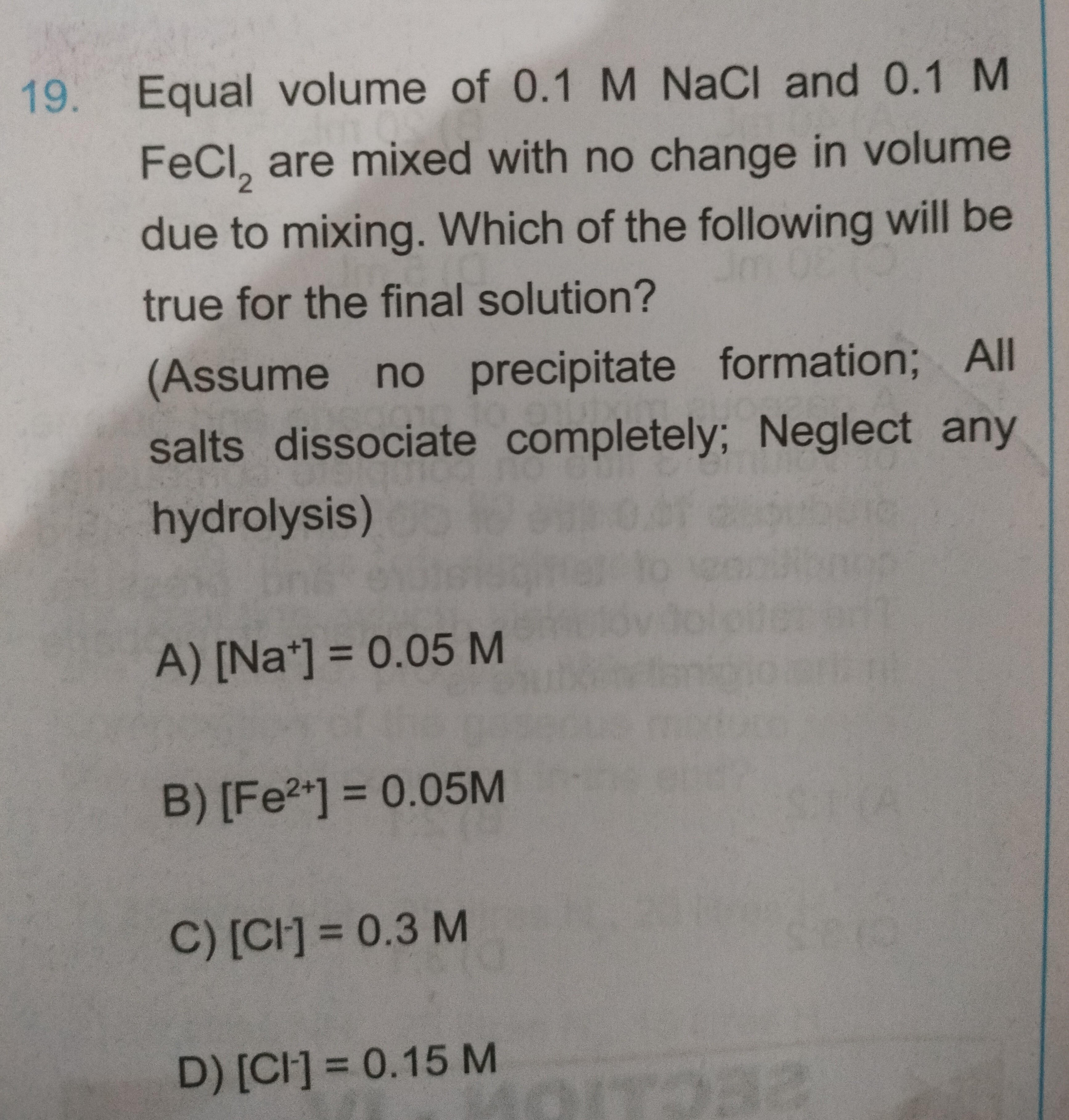Question
Question: Equal volume of 0.1 M NaCl and 0.1 M FeCl$_2$ are mixed with no change in volume due to mixing. Whic...
Equal volume of 0.1 M NaCl and 0.1 M FeCl2 are mixed with no change in volume due to mixing. Which of the following will be true for the final solution? (Assume no precipitate formation; All salts dissociate completely; Neglect any hydrolysis)

[Na+] = 0.05 M
[Fe2+] = 0.05M
[Cl−] = 0.3 M
[Cl−] = 0.15 M
A, B, D
Solution
To determine the concentrations of ions in the final solution, we need to consider the initial moles of each ion and the total final volume.
Let's assume the equal volume of each solution is V liters.
1. Moles of ions from 0.1 M NaCl solution:
NaCl dissociates as: NaCl→Na++Cl−
Concentration of NaCl = 0.1 M
Moles of Na+ in V liters = 0.1 mol/L×V L=0.1V moles
Moles of Cl− in V liters (from NaCl) = 0.1 mol/L×V L=0.1V moles
2. Moles of ions from 0.1 M FeCl2 solution:
FeCl2 dissociates as: FeCl2→Fe2++2Cl−
Concentration of FeCl2 = 0.1 M
Moles of Fe2+ in V liters = 0.1 mol/L×V L=0.1V moles
Moles of Cl− in V liters (from FeCl2) = 2×(0.1 mol/L×V L)=0.2V moles
3. Total volume of the final solution:
Since equal volumes are mixed and there is no change in volume, the total volume = V L+V L=2V L.
4. Final concentrations of ions in the mixed solution:
-
Concentration of Na+:
Total moles of Na+ = 0.1V moles
[Na+]=Total volumeTotal moles of Na+=2V L0.1V moles=0.05 M
So, option A is correct.
-
Concentration of Fe2+:
Total moles of Fe2+ = 0.1V moles
[Fe2+]=Total volumeTotal moles of Fe2+=2V L0.1V moles=0.05 M
So, option B is correct.
-
Concentration of Cl−:
Total moles of Cl− = Moles of Cl− (from NaCl) + Moles of Cl− (from FeCl2)
Total moles of Cl− = 0.1V moles+0.2V moles=0.3V moles
[Cl−]=Total volumeTotal moles of Cl−=2V L0.3V moles=0.15 M
So, option D is correct, and option C is incorrect.
Therefore, options A, B, and D are all true for the final solution.
Explanation of the solution:
When equal volumes of two solutions are mixed, the moles of each solute are conserved, but the total volume doubles. The final concentration of an ion is calculated by dividing its total moles by the total volume.
- For NaCl (0.1 M): Moles of Na+ = 0.1V, Moles of Cl− = 0.1V.
- For FeCl2 (0.1 M): Moles of Fe2+ = 0.1V, Moles of Cl− = 2 * 0.1V = 0.2V.
- Total volume = 2V.
- [Na+]=2V0.1V=0.05 M.
- [Fe2+]=2V0.1V=0.05 M.
- [Cl−]=2V0.1V+0.2V=2V0.3V=0.15 M.
